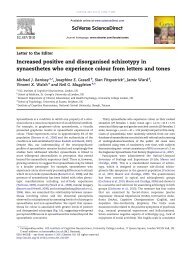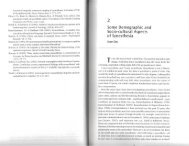A strong parietal hub in the small-world - Synesthesia
A strong parietal hub in the small-world - Synesthesia
A strong parietal hub in the small-world - Synesthesia
You also want an ePaper? Increase the reach of your titles
YUMPU automatically turns print PDFs into web optimized ePapers that Google loves.
Small-<strong>world</strong> network of coloured-hear<strong>in</strong>g synaes<strong>the</strong>tes 191<br />
<strong>the</strong> vic<strong>in</strong>ity of <strong>the</strong> <strong>in</strong>tra<strong>parietal</strong> sulcus, a bra<strong>in</strong> area that separates <strong>the</strong> superior from <strong>the</strong><br />
<strong>in</strong>ferior <strong>parietal</strong> lobule. Taken toge<strong>the</strong>r, our approach us<strong>in</strong>g rest<strong>in</strong>g state EEG streng<strong>the</strong>ns<br />
<strong>the</strong> notion that <strong>the</strong> <strong>parietal</strong> cortex plays a pivotal role <strong>in</strong> synaes<strong>the</strong>sia and that this area<br />
is functionally and anatomically specific for this particular group.<br />
In contrast to <strong>the</strong> o<strong>the</strong>r frequency bands, we identified two <strong>hub</strong>s <strong>in</strong> <strong>the</strong> <strong>parietal</strong> lobe<br />
for <strong>the</strong> beta band: one more anteriorly located <strong>in</strong> <strong>the</strong> vic<strong>in</strong>ity of <strong>the</strong> postcentral gyrus and<br />
<strong>the</strong> o<strong>the</strong>r located <strong>in</strong> <strong>the</strong> angular gyrus. Why <strong>the</strong>se <strong>hub</strong>s for <strong>the</strong> beta band are found at<br />
different locations <strong>in</strong> <strong>the</strong> <strong>parietal</strong> lobe than <strong>the</strong> <strong>parietal</strong> <strong>hub</strong>s for <strong>the</strong> o<strong>the</strong>r frequency band<br />
is currently unclear. However, <strong>in</strong> a very recent study with grapheme-colour synaes<strong>the</strong>tes,<br />
TMS stimulation over a left-sided parietooccipital area suppressed implicit bidirectionally<br />
<strong>in</strong> synaes<strong>the</strong>sia (Ro<strong>the</strong>n et al., 2010). In o<strong>the</strong>r words, <strong>the</strong> bidirectional cross-activation of<br />
grapheme and colour <strong>in</strong>formation was not possible anymore after disrupt<strong>in</strong>g <strong>the</strong> activity<br />
<strong>in</strong> <strong>the</strong> parietooccipital area. S<strong>in</strong>ce TMS stimulation to parietooccipital areas def<strong>in</strong>itively<br />
coactivates <strong>the</strong> angular gyrus, it is possible that <strong>the</strong> angular gyrus is also <strong>in</strong>volved <strong>in</strong><br />
controll<strong>in</strong>g bidirectionality. Accord<strong>in</strong>gly, <strong>in</strong>ferior <strong>parietal</strong> areas (<strong>in</strong>clud<strong>in</strong>g <strong>the</strong> angular<br />
gyrus) are also <strong>in</strong>volved <strong>in</strong> synaes<strong>the</strong>sia. Our orig<strong>in</strong>al hypo<strong>the</strong>sis placed more attention on<br />
<strong>the</strong> particular location, which has been outl<strong>in</strong>ed by Hubbard (2007), and which is located<br />
<strong>in</strong> <strong>the</strong> vic<strong>in</strong>ity of <strong>the</strong> <strong>in</strong>tra<strong>parietal</strong> sulcus, not <strong>in</strong> <strong>the</strong> angular gyrus or <strong>the</strong> postcentral<br />
gyrus. Perhaps <strong>the</strong> more <strong>in</strong>feriorly located <strong>parietal</strong> <strong>hub</strong> <strong>in</strong> <strong>the</strong> angular gyrus is not<br />
<strong>in</strong>volved <strong>in</strong> hyperb<strong>in</strong>d<strong>in</strong>g but <strong>in</strong> controll<strong>in</strong>g bidirectionality. However, bidirectionality<br />
has only recently become an issue <strong>in</strong> synaes<strong>the</strong>sia. It is conceivable that <strong>the</strong> two-stage<br />
model should be transformed <strong>in</strong>to a three-stage model that <strong>in</strong>cludes <strong>the</strong> control of<br />
bidirectionality. Whe<strong>the</strong>r this holds true has to be demonstrated <strong>in</strong> future studies.<br />
The auditory <strong>hub</strong><br />
We also hypo<strong>the</strong>sized <strong>strong</strong>er degree measures for synaes<strong>the</strong>tes <strong>in</strong> <strong>the</strong> auditory cortex<br />
and <strong>the</strong> fusiform area. We only identified <strong>strong</strong>er degree measures for coloured-hear<strong>in</strong>g<br />
synaes<strong>the</strong>tes <strong>in</strong> <strong>the</strong> right-sided auditory cortex but not <strong>in</strong> <strong>the</strong> fusiform area. The betweengroups<br />
difference <strong>in</strong> <strong>the</strong> auditory cortex was identified for one frequency band (alpha2).<br />
Thus, our apriorihypo<strong>the</strong>sis did not receive <strong>strong</strong> support. However, <strong>the</strong> larger degree<br />
measure for <strong>the</strong> alpha2 band related to <strong>the</strong> rest<strong>in</strong>g activity <strong>in</strong> <strong>the</strong> auditory cortex and<br />
could <strong>in</strong>dicate a <strong>strong</strong>er functional coupl<strong>in</strong>g of this area to adjacent bra<strong>in</strong> areas for<br />
<strong>the</strong> colour-hear<strong>in</strong>g synaes<strong>the</strong>tes. A <strong>strong</strong>er anatomical connectivity with<strong>in</strong> <strong>the</strong> auditory<br />
cortex has recently been shown for an extraord<strong>in</strong>ary auditory-visual synaes<strong>the</strong>te; <strong>the</strong>reby,<br />
suggest<strong>in</strong>g specific anatomical features with<strong>in</strong> <strong>the</strong> auditory system (Hanggi et al., 2008).<br />
Fur<strong>the</strong>rmore, two ERP studies have shown reduced N1 amplitudes and latencies to<br />
auditory stimuli <strong>in</strong> coloured-hear<strong>in</strong>g synaes<strong>the</strong>tes; thus, <strong>in</strong>dicat<strong>in</strong>g that <strong>the</strong> auditory<br />
cortex processes auditory <strong>in</strong>formation at an early process<strong>in</strong>g stage differently <strong>in</strong> <strong>the</strong>se<br />
synaes<strong>the</strong>tes (Beeli et al., 2008; Goller, Otten, & Ward., 2009). Based on monkey s<strong>in</strong>glecell<br />
record<strong>in</strong>g data, Goller et al. (2009) argue that this difference could be due to<br />
more or <strong>strong</strong>er react<strong>in</strong>g audiovisual neurons with<strong>in</strong> <strong>the</strong> auditory cortex respond<strong>in</strong>g to<br />
visual stimuli. This is an <strong>in</strong>terest<strong>in</strong>g argument that should be followed-up with fur<strong>the</strong>r<br />
experiments. Why only <strong>the</strong> right-sided auditory cortex turned out to be a <strong>strong</strong> <strong>hub</strong><br />
<strong>in</strong> coloured-hear<strong>in</strong>g synaes<strong>the</strong>tes is not entirely clear. The right-sided auditory cortex is<br />
more <strong>strong</strong>ly <strong>in</strong>volved <strong>in</strong> process<strong>in</strong>g pitch <strong>in</strong>formation (Hickok & Poeppel, 2007). Thus,<br />
it is possible that tone process<strong>in</strong>g <strong>in</strong> coloured-hear<strong>in</strong>g synaes<strong>the</strong>tes is <strong>in</strong>deed supported<br />
by this <strong>strong</strong> <strong>hub</strong>, which is located <strong>in</strong> <strong>the</strong> right-sided auditory cortex. Future studies,<br />
never<strong>the</strong>less, have yet to exam<strong>in</strong>e whe<strong>the</strong>r this is true. Our f<strong>in</strong>d<strong>in</strong>gs provide support for<br />
<strong>the</strong> idea that <strong>the</strong> auditory cortex is differently organized <strong>in</strong> auditory-visual synaes<strong>the</strong>tes,<br />
even <strong>in</strong> <strong>the</strong> rest<strong>in</strong>g state.




